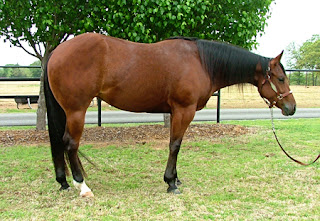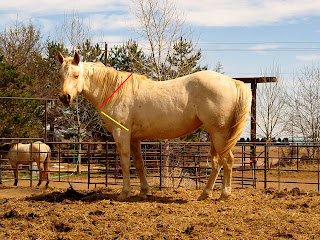The problem is, sometimes you have less than perfect conformation on a stellar horse, or seemingly good conformation on an underperformer.
Generally though, good conformation = good horse.
Even a horse with a ton of try will break down without special care and lots of attention when it's in hard work if it has a major fault or two.
Truly serious conformation faults are hardly ever seen in top performing horses.
Here's a comparison of Chev as a 2 year old (I think she was 2 years 2 months), and Sugar (we'll call her), who is 20 months.
I always kind of cringe when I see photos of Chev as a young horse (really, any time before age 4).
She was so awkward looking.
I see, specifically, calf knees (her biggest fault), straight-ish shoulder, and kinda funky looking back legs. She also had a huge head which you can't see because Keelan is blocking it in this photo.
On the plus side, she has a long neck, relatively short back, and those funky back legs are straight and feature a hugely long gaskin, which gives her a comfortable, sweeping strike in back. Her hip is a little steep but long. She tracks up well and straight. And she has grown up in a pretty nice looking horse.
Chev at 6 years old
She still has the straight shoulder, although if you look at the length between the point of her shoulder and the point of her elbow, you'll see why she has such a comfortable stride. Her calf knees straightened a bit but are still a major fault that I think about every ride. And a lot of the faults that seemed huge when she was a baby turned out to not be such a big deal after all. It turns out this conformation thing is complicated!
***DISCLAIMER: the following conformation analysis deals with specifically quarter horses! Horses are a lot like cars--there's a different style for every need.
I'd like to delve into the nitty-gritty.
A horse is generally considered to be downhill if it's hip (or croup) is higher than it's withers. Here's a conformation diagram so we're all on the same page with horse terms.
This diagram is supposed to exhibit generalized excellent conformation for the quarter horse. Both Chev and Sugar are quarter horses, but Chev is of the more modern pleasure type, and Sugar is a reining/cow bred type.
Anyway, see the croup and the withers in the drawing? Even in this great conformation diagram, most horse people would consider this horse to be "downhill", meaning he's built like he's standing with his rear legs up a hill and his forelegs down in a ditch.
Not so! I would say.
And do you know why?
Because a horse that actually travels downhill when he moves has a lot more to do with the relationship of the hocks to the knees.
As you can see in the diagram, they are almost level with each other. This is ideal.
It's also something I really like in Chevy and the little filly. They both have fairly low set hocks, which allows them to travel in a more sweeping, level way at all the gaits.
I think this horse would feel incredibly downhill to ride. And it's not just because his bum is about a mile above his withers (which might actually be sort of okay, because based on the length of his tail, he's still a 2 year old)--look at how much higher his hocks are than his knees! His front cannon bones are nice and short, but unfortunately, his front legs look like they belong to a completely different horse.
Purple line = hip to withers
Green line = hock to knee
High set hocks are a deal breaker for me.
By contrast, here's an example of a high level reining show horse:
Though she also appears downhill at first glance, her hocks are much lower, almost level with her knees, and her front legs look like they can support her frame without much trouble. She also looks like she'd be balanced and quick in her turnarounds and maneuvers--and she is.
Here's Chev and Sugar:
Even though a lot of their conformation is very dissimilar, especially overall body type, they both have fairly level toplines and are fairly level from hock to knee, even at 2 years old. That tells me Sugar is likely to grow up to be fairly balanced, even if she is a little more post legged behind.
This is a pretty good article on Reining-horse specific conformation by Les Vogt, who has really grown on me over the years: http://lesvogt.wordpress.com/2007/12/21/werent-we-talking-about-prospects/
He mentions something in particular that I was pretty worried about.
I come from the English world, where longish pasterns are coveted. They help give a springy stride, and, I thought, also help with long term soundness.
Turns out you don't want longish pasterns in a reining horse or a horse that has to do a lot of quick, difficult maneuvers. I thought Chev had pretty short pasterns, but as you can see, Sugar's are shorter still.
The last thing I want to talk about is shoulder slope.
It's another area of horse conformation that isn't well understood.
Different sloped shoulders are good for different things. Generally, the more upright the shoulder, the more "torque", and the less "reach".
For example, pulling horses have very upright shoulders: Clydesdales, Percherons, Draft breeds.
Here's a Clydesdale stallion:
Red line = shoulder slope
Yellow line = humerus length
Angle between lines = ~ 90 degrees
Even though his shoulder is steep (about 55 degrees), which is as expected with his breed standard, the length of his humerus (arm bone) is just about ideal at around 60% of his shoulder length. The angle is also good between shoulder and humerus at 90 degrees. This means despite the upright shoulder, he can reach out a bit and get a lot of power out of his strides. The steep angles also lend themselves to a lot of knee action.*
*Side note: This is why, interestingly, a lot of draft crosses (particularly when crossed on sloped shoulder breeds like the Thoroughbred) can, ironically, turn out to be good jumpers, because the combination of steep shoulder angle (which gives good knee action and "push") and long humerus (which allows for reach and length of stride) lends itself well to jumping! Most warmblood breeds that excel in jumping have the straight shoulder/long humerus combination. If you've seen a horse jump in slow motion, you'll be shocked to see almost all of the push to get over the jump comes from the front end, not the rear.
*Side note: This is why, interestingly, a lot of draft crosses (particularly when crossed on sloped shoulder breeds like the Thoroughbred) can, ironically, turn out to be good jumpers, because the combination of steep shoulder angle (which gives good knee action and "push") and long humerus (which allows for reach and length of stride) lends itself well to jumping! Most warmblood breeds that excel in jumping have the straight shoulder/long humerus combination. If you've seen a horse jump in slow motion, you'll be shocked to see almost all of the push to get over the jump comes from the front end, not the rear.
Let's try Chev, since she has an apparently terrible shoulder angle at first glance:
Shoulder slope = ~50-55 degrees
Shoulder angle = ~90 degrees
Humerus length = ~65%
She has a somewhat steep shoulder slope (between 50-55 degrees) but a long humerus that is very good at 65% length of her shoulder. This helps to explain some of her sweeping action at the trot, and is the reason she can push out for English classes. The slightly steeper shoulder is still open enough, with about a 90 degree angle between shoulder slope and humerus. If the humerus is too long or too short, reach can be limited. But her humerus is long enough and sloped enough to give her pretty good reach. She still prefers to jog, though.
Here's Sugar, who's still young and will likely change a bit:
Shoulder slope = 45 degrees
Shoulder angle = 85 degrees
Humerus length = 65%
Shoulder angle = 85 degrees
Humerus length = 65%
Because of her mane, it was hard for me to really see the slope of her shoulder, but I know she has a much more sloped shoulder than Chev does. Her shoulder slope is about 45 degrees, or "laid back". The angle between her shoulder slope and her humerus is about 85 degrees (adequate), and her humerus length (at 20 months) is about 65% the length of her shoulder. I think it's likely that her shoulder slope will become a little steeper as she grows, which should give her angles similar to Chev's.
Finally, the professional reining horse:
Shoulder slope = 50 degrees
Shoulder angle = 85 degrees
Humerus length = 80%
Her angles are similar to Sugar's (which isn't surprising, since they're both reining bred): Shoulder slope is about 50 degrees, shoulder angle between shoulder and humerus is about 85 degrees, and the humerus is long at 80% the shoulder's total length. Historically a long humerus causes the horse to stand more under itself, which is exactly what this horse is doing--but it's also important to consider that photo angles can drastically change the appearance of lengths and angles, and this photo would be much more ideal if the horse was standing more square up front.
Anyway, I'm too tired to know if any of this makes sense anymore--G'nite!














I'm not seeing that Chev is calf kneed. I'm eyeballing...drawing a line through her bones and joint, and it really doesn't look like she is back at the knee. Could you explain why you think she is?
ReplyDeleteHi, Ponyrider--She did straighten out A LOT as she grew. It's much more apparent in the 2 year old photos. Enlarge those & you'll see it clearly. The more current photos look fairly normal, even to my eye, although it is more obvious in person.
Delete